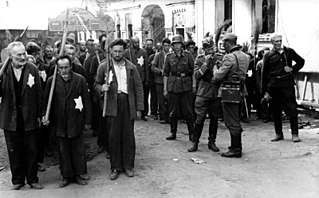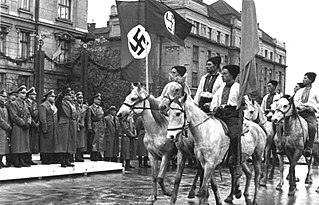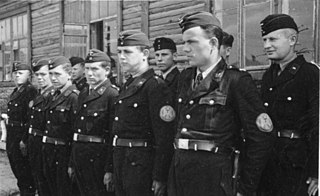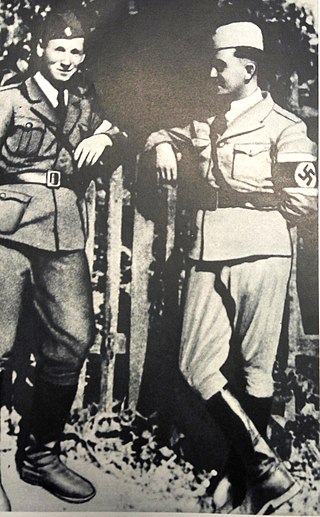
The Ordnungspolizei, abbreviated Orpo, meaning "Order Police", were the uniformed police force in Nazi Germany from 1936 to 1945. The Orpo organisation was absorbed into the Nazi monopoly on power after regional police jurisdiction was removed in favour of the central Nazi government. The Orpo was controlled nominally by the Interior Ministry, but its executive functions rested with the leadership of the SS until the end of World War II. Owing to their green uniforms, Orpo were also referred to as Grüne Polizei. The force was first established as a centralised organisation uniting the municipal, city, and rural uniformed police that had been organised on a state-by-state basis.

The 20th Waffen Grenadier Division of the SS was a foreign infantry division of the Waffen-SS that served alongside but was never formally part of the Wehrmacht during World War II. According to some sources, the division was under Reichsführer-SS Heinrich Himmler's overall command but was not an integral part of the Schutzstaffel (SS). It was officially activated on 24 January 1944, and many of its soldiers had been members of the Estonian Legion and/or the 3rd Estonian SS Volunteer Brigade, which had been fighting as part of German forces since August 1942 and October 1943 respectively. Both of the preceding formations drew their personnel from German-occupied Estonia. Shortly after its official activation, widespread conscription within Estonia was announced by the German occupying authorities. The division was formed in Estonia around a cadre comprising the 3rd Estonian SS Volunteer Brigade, and was initially known as the 20th Estonian SS Volunteer Division.

The German invasion of the Soviet Union started on 22 June 1941 and led to a German military occupation of Byelorussia until it was fully liberated in August 1944 as a result of Operation Bagration. The western parts of Byelorussia became part of the Reichskommissariat Ostland in 1941, and in 1943, the German authorities allowed local collaborators to set up a regional government, the Belarusian Central Rada, that lasted until the Soviets reestablished control over the region. Altogether, more than 2 million people were killed in Belarus during the three years of Nazi occupation, almost a quarter of the region's population, including 500,000 to 550,000 Jews in the Holocaust in Belarus.

The Schutzmannschaft, or Auxiliary Police was the collaborationist auxiliary police of native policemen serving in those areas of the Soviet Union and the Baltic states occupied by Nazi Germany during World War II. Heinrich Himmler, head of the SS, established the Schutzmannschaft on 25 July 1941, and subordinated it to the Order Police. By the end of 1941, some 45,000 men served in Schutzmannschaft units, about half of them in the battalions. During 1942, Schutzmannschaften expanded to an estimated 300,000 men, with battalions accounting for about a third, or less than one half of the local force. Everywhere, local police far outnumbered the equivalent German personnel several times; in most places, the ratio of Germans to natives was about 1-to-10.

Ukrainian collaboration with Nazi Germany took place during the occupation of Poland and the Ukrainian SSR, USSR, by Nazi Germany during the Second World War.

The 30th Waffen Grenadier Division of the SS(1st Belarusian), originally called the 30th Waffen Grenadier Division of the SS , was a short-lived German Waffen-SS infantry division formed largely from Belarusian, Russian, Polish, and Ukrainian personnel of the Schutzmannschaft-Brigade Siegling in August 1944 at Warsaw in the General Government.
A field force in British and Indian Army military parlance is a combined arms land force operating under actual or assumed combat circumstances, usually for the length of a specific military campaign. It is used by other nations, but can have a different meaning.
The Belarusian Home Defence, or Belarusian Home Guard were collaborationist volunteer battalions formed by the Belarusian Central Council (1943–1944), a pro-Nazi Belarusian self-government within Reichskommissariat Ostland during World War II. The BKA operated from February 23, 1944 to April 28, 1945. The 20,000 strong Belarusian Home Defence Force was formed under the leadership of Commissioner-General Curt von Gottberg, with logistical help from the German 36th Waffen Grenadier Division of the SS known as the "Poachers' Brigade" commanded by Oskar Dirlewanger.

The Ukrainian Auxiliary Police was the official title of the local police formation set up by Nazi Germany during World War II in Eastern Galicia and Reichskommissariat Ukraine, shortly after the German occupation of the Western Ukrainian SSR in Operation Barbarossa.

The Belarusian Auxiliary Police was a German force established in July 1941 in occupied Belarus, staffed by local inhabitants, considered collaborationist. In western Belarus, auxiliary police were formed in the form of Schutzmanchaften units, while in the east they were formed in the form of Ordnungsdienst.

Latvian Auxiliary Police was a paramilitary force created from Latvian volunteers and conscripts by the Nazi German authorities who occupied the country in June/July 1941. It was part of the Schutzmannschaft (Shuma), native police forces organized by the Germans in occupied territories and subordinated to the Order Police. Some units of the Latvian auxiliary police were involved in the Holocaust.

Schutzmannschaft-Brigade Siegling was a Belarusian Auxiliary Police brigade formed by Nazi Germany in July 1944 in East Prussia, from six auxiliary police battalions following the Soviet Operation Bagration.
Estonian Auxiliary Police were Estonian collaborationist police units during World War II.

Barys Rahula was a Belarusian political activist. He served as a military commander of the Belarusian auxiliary police unit Schutzmannschaft Battalion 68. After the war he studied medicine in the West and became a doctor in Canada.

During World War II, some Belarusians collaborated with the invading Axis powers. Until the beginning of Operation Barbarossa in 1941, the territory of Belarus was under control of the Soviet Union, as the Byelorussian Soviet Socialist Republic. However, memories of Soviet repressions in Belarus and collectivization, as well as of the polonization and discrimination against Belarusians under the Second Polish Republic were still fresh.

Schutzmannschaft Battalion 118 was a Schutzmannschaft auxiliary police battalion (Schuma). The core of the Schutzmannschaft battalion 118 consisted of Ukrainian nationalists from Bukovina in western Ukraine. It was linked to the ultra-nationalist Organization of Ukrainian Nationalists, to its smaller Melnyk wing. Nine-hundred members of the OUN in Bukovina marched towards eastern Ukraine as members of the paramilitary Bukovinian Battalion. After reinforcement by volunteers from Galicia and other parts of Ukraine, the Bukovinian Battalion had a total number of 1,500–1,700 soldiers. When the Bukovinian Battalion was dissolved, many of its members and officers were reorganized as Schutzmannschaft battalions 115 and 118. Among the people incorporated into the Schutzmannschaft battalions 115 and 118 were Ukrainian participants in the Babi Yar massacre.

The Lithuanian Auxiliary Police was a Schutzmannschaft formation formed during the German occupation of Lithuania between 1941 and 1944, with the first battalions originating from the most reliable freedom fighters that were disbanded following the anti-Soviet Lithuanian June Uprising in 1941. Lithuanian activists hoped that these units would be the basis of the reestablished Lithuanian Army and commanded by the Lithuanian Provisional Government. Instead, these units were placed under the orders of the SS- und Polizeiführer in Lithuania.

Hryhoriy Mykytovych Vasiura was originally a senior lieutenant in the Red Army who was captured during the Nazi invasion of the USSR in 1941 and subsequently volunteered for service in the Schutzmannschaft and the Waffen-SS. Vasiura's wartime activities were not fully revealed until the mid-1980s, when he was convicted as a war criminal by a Soviet military court and executed in 1987 for his role in the Khatyn massacre.
Vasyl Andriyovych Meleshko was a Ukrainian war criminal who participated in the Khatyn massacre.
64th Belarusian Auxiliary Police Battalion was a Belarusian Auxiliary Police battalion that existed in 1944, at the very end of the German occupation of Byelorussia during World War II. It was composed from the Belarusians of Hlybokaye.















